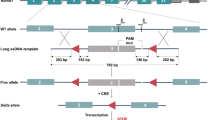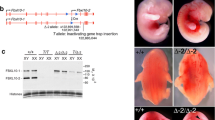Abstract
Looptail (Lp) is a mutation on the distal portion of mouse Chromosome (Chr) 1 that affects neurulation in mouse and is phenotypically expressed by appearance of an open neural tube along the entire antero-posterior axis of the embryo (craniorachischisis). Nhlh1, a member of the basic helix-loop-helix family of transcription factors, is expressed in the developing neural tube in structures affected by the Lp mutation and has been regionally assigned to the distal part of mouse Chr 1. Using a large panel of looptail animals from an (Lp/+ x SWR/J)F1 x SWR/J segregating backcross progeny, we have determined that Nhlh1 maps very close to Lp, with no recombinant detected in 500 informative animals tested; both map within a 0.6-cM segment defined as D1Mit113/apoa2/Fcer1γ-(0.4 cM)-Nhlh1/Lp-(0.2 cM)-Fcer1α/D1Mit149/Spna1. Nucleotide sequencing of Nhlh1 cDNA clones from wild type (WT) and Lp/Lp embryos failed to identify sequence alterations associated with the mutant phenotype. Southern hybridization of genomic DNA from WT and Lp/Lp embryos failed to identify specific rearrangements at or near the Nhlh1 locus, and Northern RNA blotting and RT-PCR evaluation of Nhlh1 mRNA expression indicated that both the levels and types of Nhlh1 mRNAs produced in WT and Lp/Lp embryos were indistinguishable. These studies suggest that Nhlh1 and Lp are not allelic. Nevertheless, Nhlh1 is the Chr 1 marker most tightly linked to Lp identified to date and can, therefore, be used as an excellent entry probe to clone the Lp region.
Similar content being viewed by others
References
Aplan, P.D., Begley, C.G., Bertness, V., Nussmeier, M., Ezquerra, A., Coligan, J., Kirsch, I.R. (1990). The Scl gene is formed from a transcriptionally complex locus. Mol. Cell. 10, 6426–6435.
Begley, C.G., Lipkowitz, S., Göbel, V., Mahon, K.A., Bertness, V., Green, A.R., Gough, N.M., Kirsch, I.R. (1992). Molecular characterization of NSCL, a gene encoding a helix-loop-helix protein expressed in the developing nervous system. Proc. Natl. Acad. Sci. USA 89, 38–42.
Brown, L., Espinosa III, R., Le Beau, M.M., Siciliano, M.J., Baer, R. (1992). HEN1 and HEN2: a subgroup of basic helix-loop-helix genes that are coexpressed in a human neuroblastoma. Proc. Natl. Acad. Sci. USA 89, 8492–8496.
Cabrera, C.V., Martine-Arias, A., Bate, M. (1987). The expression of three members of the achaete-scute gene complex correlates with neuroblast segregation in Drosophila. Cell 50, 425–433.
Caudy, M., Vässin, H., Brand, M., Tuma, R., Jan, L.Y., Jan, Y.N. (1988). daughterless, a Drosophila gene essential for both neurogenesis and sex detrmination, has sequence similarities to myc and the achaete-scute complex. Cell 55, 1061–1067.
Chirgwin, J.M., Przybyla, A.A., MacDonald, R.J., Rutter, W.J. (1979). Isolation of biologically active ribonucleic acid from sources enriched in ribonucleases. Biochemistry 18, 5294–5299.
Copp, A.J., Brook, F.A., Estibiero, J.P., Shum, A.S.W., Cockroft, D.L. (1990). The embryonic development of mammalian neural tube defects. Prog. Neurobiol. 35, 363–403.
Copp, S.N., Wilson, D.B. (1981). Cranial glycosaminoglycans in early embryos of the Looptail (Lp) mutant mouse. J. Craniofac. Genet. Dev. Biol. 1, 253–260.
Davis, R.L., Cheng P.-F., Lassar, A.B., Weintraub, H., (1990). The MyoD DNA binding domain contains a recognitiou code for muscle specific gene activation. Cell 60, 737–746.
Dietrich, W., Kalz, H., Lincoln, S.E., Shin, H.-S., Freidman, J., Dracopoli, N.C., Lander E.S. (1992). A genetic map of the mouse suitable for typing intraspecific crosses. Genetics 131, 423–447.
Dveksler, G.S., Basile, A.A., Dieffenbach, C.W. (1992). Analysis of gene expression: Use of oligonucleotide primers for glyceraldehyde-3-phosphate dehydrogenase. In PCR Methods and Applications, (Cold Spring Harbor, N.Y.: Cold Spring Harbor Laboratory Press) I, 283–285.
Epstein, D.J., Vekemans, M., Gros, P. (1991). Splotch (Sp 2H), a mutation affecting development of the mouse neural tube, shows a deletion within the paired homeodomain of Pax-3. Cell 67, 767–774.
Festing, M.F.W. (1989). Inbred strains of mice. In Genetic Variants and Strains of the Laboratory Mouse, M.F. Lyon, A.G. Searle, eds. (Oxford: Oxford Univ. Press), pp. 636–648.
Göbel, V., Lipkowitz, S., Kozak, C.A., Kirsch, I.R. (1992). NSCL-2: a basic domain helix-loop-helix gene expressed in early neurogenesis. Cell Growth Differ. 3, 143–148.
Gough, N.M., Lipkowitz, S., Kirsch, I.R., Begley, C.G. (1992). Localization of murine HLH gene NSCL to Chromosome 1 by use of recombinant inbred strains. Mamm. Genome 3, 182–183.
Green, E.L. (1981) Breeding systems. In The Mouse in Biomedical Research, H.L. Foster, J.D. Small, J.G. Fox, eds. (New York: Academic Press), p. 91.
Holton, T.A., Graham, M.W. (1991). A simple and efficient method for direct cloning of PCR products using ddT-tailed vectors. Nucleic Acids Res. 19, 1156.
Lipkowitz, S., Gobel, V., Varterasian, M.L., Nakahara, K., Tchorz, K., Kirsch, I.R. (1992). A comparative structural characterization of the human NSCL1 and NSCL2 genes. J. Biol. Chem. 267 21065–21071.
Mellentin, J.D., Smith, S.D., Cleary, M.L. (1989). lyl-1, a novel gene altered by chromosomal translocation in T cell leukemia, codes for a protein with a helix-loop-helix DNA binding motif. Cell 58, 77–83.
Mullick, A., Trasler, D., Gros, P. (1995). High resolution linkage map in the vicinity of the Lplocus. Genomics 26, 479–488.
Sambrook, J., Fritsch, E.F., Maniatis, T. (1989). Molecular Cloning: A Laboratory Manual. (Cold Spring Harbor, N.Y.: Cold Spring Harbor Laboratory Press).
Schurr, E., Skamene, E., Forget, A., Gros, P. (1989). Linkage analysis of the Bcg gene on mouse chromosome 1: Identification of a tightly linked marker. J. Immunol. 142, 4507–4513.
Schurr, E., Skamene, E., Morgan, K., Chu, M.-L., Gros, P. (1990). Mapping of Col3al and Col6a3 to proximal murine chromosome 1 identifies conserved linkage of structural protein genes between murine chromosome 1 and human chromosome 2q. Genomics 8, 477–486.
Smith, L.J., Stein, K.F. (1962). Axial elongation in the mouse and its retardation in homozygous looptail mice. J. Embryol. Exp. Morphol. 10, 73–87.
Strong, L.C., Hollander, W.F. (1949). Hereditary loop-tail in the house mouse. J. Hered. 40, 329–334.
Vidal, S.M., Malo, D., Vogan, K., Skamene, E., Gros, P. (1993). Natural resistance to infection with intracellular parasites: isolation of a candidate for Bcg. Cell 73, 469–485.
Villares, R., Cabrera, C.V. (1987). The achaete-scute gene complex of D. melanogaster: conserved domains in a subset of genes required for neurogenesis and their homology to myc. Cell 50, 415–424.
Author information
Authors and Affiliations
Rights and permissions
About this article
Cite this article
Mullick, A., Groulx, N., Trasler, D. et al. Nhlh1, a basic helix-loop-helix transcription factor, is very tightly linked to the mouse looptail (Lp) mutation. Mammalian Genome 6, 700–704 (1995). https://doi.org/10.1007/BF00354291
Received:
Accepted:
Issue Date:
DOI: https://doi.org/10.1007/BF00354291




